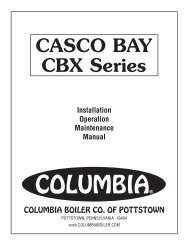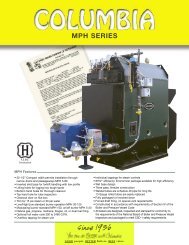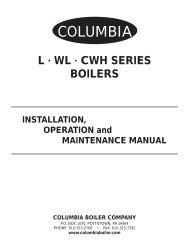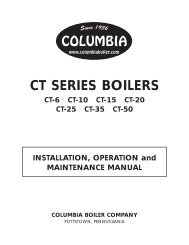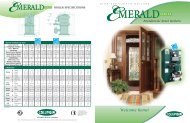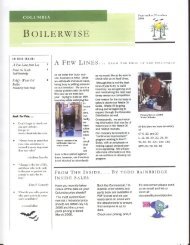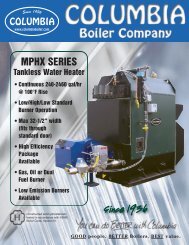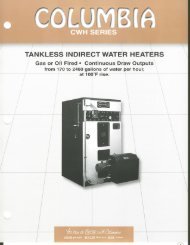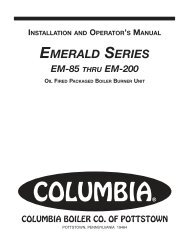CT Manual 1-up - Columbia Boiler
CT Manual 1-up - Columbia Boiler
CT Manual 1-up - Columbia Boiler
You also want an ePaper? Increase the reach of your titles
YUMPU automatically turns print PDFs into web optimized ePapers that Google loves.
for the precipitation of scale forming salts before scale is deposited.Below a pH of 5.0 the water is acidic enough to dissolve the steel boiler plates. Underthese conditions the steel gradually becomes thinner and thinner until its destruction. At apH between 5 and 9.4 pitting of shell plates will occur at a rate depending on the amountof dissolved oxygen in the boiler.Dissolved OxygenDissolved oxygen is caused by the solubility of atmospheric oxygen into the s<strong>up</strong>ply water.Aeration of the city water s<strong>up</strong>ply is frequently used to remove other noxious gasses.Efficient aeration results in saturation of the water with oxygen.the majority of corrosion problems are directly related to the quantity of dissolved oxygenin the boiler water. Elimination of the corrosive effect of dissolved oxygen can be accomplishedboth directly or chemically.Direct or mechanical removal of dissolved oxygen is done through the use of a deaeratoror by heating the water to a temperature above 180°F. Heating the water can be donewith a preheater or a sparge tube installed in the return system.Chemical deaerator is done through the introduction of specific chemicals in the boiler toreact with the oxygen. The dissolved oxygen content should be maintained at a minimumbut at no time should it exceed 0.007 mg/l.SulfitesSodium sulfite is generally used for the chemical removal of dissolved oxygen within theboiler water. To assure the rapid and complete removal of the oxygen entering the boilerfeedwater system the concentration of sulfite in the boiler must be maintained at a minimumof 20 PPM. (parts per million)SolidsSolids can be broken <strong>up</strong> into two categories: suspended solids, and dissolved solids.Suspended solids are those which can be removed by filtration, while dissolved solids arein solution with the water. The best test for the determination of solids content of the boilerwater is through a conductance test.The conductance value of boiler water varies by the various ionized salts present. The conductancecan be used to measure the total dissolved solids in the boiler water and to serveas an accurate means for the control of solids through the use of blowdown.Another test which is sometimes used as a gauge of solids is to measure the chloride presentin the boiler water. The ratio of chlorides in the boiler water to that of the feed watercan be used as a means to determine the amount of blowdown required. The chloride testis unsuitable for feedwater with low incoming concentrations and the concentrations in thefeedwater must be averaged over time for accuracy.FM-148 COLUMBIA BOILER COMPANY, REV 6-06- 40 -



